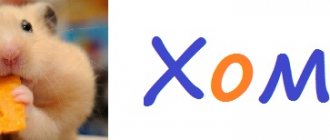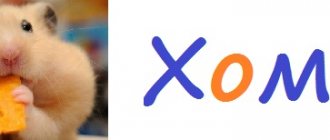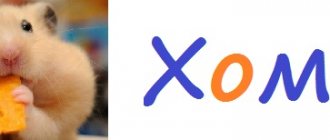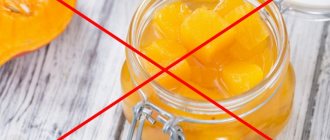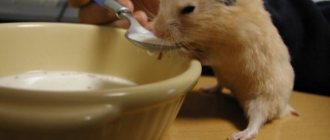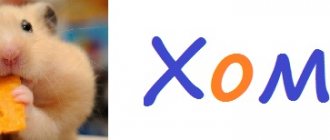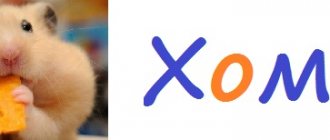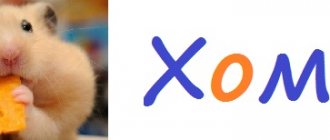Proper, nutritious and at the same time varied nutrition is the key to health and long life.
And this is true not only in people, but also in animals and hamsters. To make your pet's coat look healthy and shiny (and this is one of the external signs that allows you to determine the pet's current condition), you need to feed the rodent according to the following scheme: the basis of the diet is dry food, in addition - vegetables and fruits. But here the question arises about cereals; not all of them are healthy. But today all myths will be dispelled, and answers to questions will be found.
The need for cereals for hamsters
When providing a complete diet for rodents, the cereals included in it should be taken into account. Cereals for a hamster are a base that cannot be replaced. Cereals contain many microelements that have a positive effect on the pet’s life expectancy and its general condition. And the protein included in them becomes the basis for gaining muscle mass and determines the activity of the hamster.
Regardless of what kind of cereal you give your animal, it must be included in the diet. Otherwise, you risk depriving your hamster of a large amount of nutrients, which will have negative consequences on its health and immune system.
Pay attention to the quality of cereals that hamsters eat. It is better to buy them from a pet store than from the open market to prevent them from having harmful residue or poison in the form of pesticides, which is often found from private sellers.
The balance of the hamster's cereal intake needs to be controlled; it needs to be fed about twice a day. Follow some rules regarding cereals:
- Heavy cereals (boiled porridge, millet, lentils) should be given to rodents in the first half of the day so that they have time to completely digest them.
- There is no need to repeat typical grains in the diet (bulgur and wheat, oats and oat flakes) to avoid oversaturation with vitamins or lack thereof.
- Combine cereals, alternating them with the base one - wheat; any cereals and cereals can be combined with it.
Make your hamster's diet as varied as possible, however, when introducing new grains into the diet, do it gradually, monitoring the reaction of his body.
Cereals can and should be combined with each other, the beneficial substances contained in wheat complement oatmeal well, and pearl barley goes well with buckwheat. It is also not recommended to take rice and buckwheat at the same time, as the mixture will be heavy for the animal’s intestines.
For one day, a rodent's diet requires 30 grams of a dry mixture consisting of cereals. When cooking porridge, consider the weight of dry cereals.
Useful material
Buckwheat contains many different useful substances: iron, phosphorus, potassium, calcium, copper, iodine, zinc, boron, fluorine, 18 amino acids. It contains vitamins B1, B2, B9, PP, vitamin E. Buckwheat contains a lot of protein and is a low-carbohydrate product.
Folic acid (vitamin B9) stimulates the work of red bone marrow, promotes the rapid formation, development and maturation of blood cells. Increases the body's endurance and resistance to various diseases.
Buckwheat raw and boiled
When selecting cereals for hamsters, most often animal owners try to find out whether hamsters can eat buckwheat, since it often becomes the basis of their pets’ diet. It needs to be given to get basic microelements, starting from an early age of the pet.
It helps improve blood circulation and brain function, and is often taken as a medicine for toxic poisoning of an animal.
It can be taken in three forms:
- Raw. A hamster can eat raw buckwheat if it is completely healthy, so it can take in the maximum amount of vitamins contained in the cereal. It is recommended to feed your pets dry buckwheat so that the cereal is better digestible.
- Boiled. This method should be used least often, since the option is not very useful for the animal; it helps to restore strength in case of illness. It is recommended to cook it in water, since milk has a bad effect on the health of rodents.
- Soaked. This method can be compared with the first in terms of the number of beneficial properties; for this, buckwheat is soaked overnight in warm water.
Buckwheat porridge should be introduced into the diet of hamsters, but keep in mind that it should not occupy the main place in it. Combine methods of preparing cereals, feeding him mainly raw and soaked buckwheat, and boiled buckwheat only for illnesses.
Pearl barley
The product is allowed to be included in the diet - you can steam it a little, make it as for regular porridge. Just no spices or salt! The latter are very harmful, if not dangerous, for hamsters.
Pearl barley brings the same benefits to the body as buckwheat; there is nothing dangerous in this cereal. The only thing is that the hamster may not eat everything, but drag some of it into its hole. It is better to remove such deposits, otherwise the attractive delicacy will soon turn into poison.
Experienced hamster breeders do not recommend feeding your pet rice all the time, since this grain is still heavier than regular boiled buckwheat.
For young animals and in case of illness/diarrhea, rice will come in handy. But everything needs moderation, so this is more of an “on duty” option.
Oats and oat flakes
Oatmeal is often included by pet owners in their diet. You can give your hamster oats in steamed form, but this should be done if you are sick or with small hamsters. Healthy animals are recommended to eat dry flakes, as they are digested faster and have a positive effect on the pet’s digestion.
Hamsters can eat oats in two forms:
- Oatmeal - rolled oats is best eaten by young hamsters, as it is softer and has a gentler effect on the pet’s digestive system.
- Oatmeal is useful for hamsters, but is not always well digested, especially with low immunity. It is recommended for hamsters to eat it boiled or soaked, as it can damage your pet’s teeth.
You can dilute the diet with sprouted oats; they are quickly absorbed and help improve the quality of teeth and wool.
Millet and wheat
Porridges with similar names have different recommendations. Millet is a small, hard grain that is difficult for hamsters to chew and digest, but it also contains many useful microelements. It is recommended to give it occasionally and in small quantities, or completely exclude it from the hamster’s diet.
Wheat is a grain that can be eaten in almost any form. For better absorption, it is recommended to give it in crushed form, sprout it or soak it. Whole wheat is poorly absorbed by the hamster's body. Sprouted wheat can be purchased at a pet store, or sprouted at home. You can start feeding hamsters wheat by introducing it in the form of porridge, which can be cold brewed overnight.
You should only buy sprouted wheat at a pet store to prevent intoxication of the animal, or you can sprout the grain at home.
Rice boiled and dry
Rice is a source of many beneficial substances in its natural form. It undergoes processing before entering the store, which is why it loses all its beneficial properties. Because of this, cereals are not of particular value, and it makes no sense to feed the hamster rice.
In addition, regardless of the method of preparing porridge, it is heavy for the animal’s body, and therefore can lead to digestive diseases. Be especially careful when using wild varieties of rice, as they can lead to intoxication of the animal’s body.
But if you have intestinal problems, you can carefully introduce rice porridge into your diet. Most often it is used for diarrhea, or for the successful growth of young individuals. But for this, it is recommended to feed them rice once or twice a week, using one option for preparing porridge - pre-soaking it for 7-10 hours.
But rice can be used in another form; a medicinal decoction can be made from it, which is used instead of water to treat rodents from diarrhea. It effectively helps eliminate the problem while safely affecting the digestive system.
Other cereals
Less common grains can be used to add variety to a hamster's diet, regardless of their origin. You can select varieties of grains based on the health status of your pet. This way you can balance his diet, preventing deficiency or oversaturation of the body with microelements.
In addition to the standard options, hamsters can also eat other types of cereals:
- Pearl barley. It has a positive effect on the health of the animal and can be used as an analogue of buckwheat. It is recommended to eat it steamed; to do this, you need to steep the porridge in warm water for an hour. Be careful - individuals can hide part of the food in a hole, keep track of this to prevent your pet from being poisoned by stale porridge.
- Lentils. You can feed your hamster lentils; animals love this cereal, especially when boiled. It can also be used dry, which will add vitamins to the animal’s diet. Cereals are rich in fatty acids, which promote the healing of the outer skin and the restoration of the body after illness.
- Semolina. You can eat semolina porridge for your pets, but it will not bring any benefit and only contributes to weight gain, it is better to choose another alternative. But if you need to introduce it into the diet, as prescribed by a veterinarian, you need to boil it in water; semolina is not given in dry form.
- Barley. This option cannot always be used; it is suitable for healthy pets; you must first remove the outer shell. Most often it is given raw, but you can also take it in the form of sprouts. It is not recommended to germinate them for a long time; two days is enough for this.
When feeding, you should not use muesli, as they are not intended for consumption by the animal, which is why they can cause harm to the fragile organism.
Buckwheat
Buckwheat can and should be given. It is included in most grain mixtures that can be purchased at pet stores.
This product will benefit your hamster's body due to its excellent vegetable protein and nutrient content.
When deciding in what form to give this treat to your hamster, you must first assess its health. Sick rodents are usually offered porridge cooked without milk and without spices, but it is better to feed a healthy pet dry buckwheat.
All about porridge
When adding porridge to your diet, consider their beneficial properties. However, what can be given to hamsters is recommended to be administered carefully to prevent your pet from having an allergic reaction. This is rare, but there is a risk of deterioration in his health.
Also, do not forget that wet mash of cereals quickly turns sour; it should be cooked before use.
Cereals can only be eaten by animals in their natural form. When preparing for use, you cannot add salt, sugar and other spices to them, or season them with oil. Milk has a negative effect on the health of hamsters, so porridge should be cooked in water.
Boiled porridge is given to weakened and sick hamsters, because in nature they do not eat it. Regularly clean the cage from the remains of porridge, as animals often take leftover food into burrows and hide them, and if they are stored for a long time, there is a risk of poisoning the animal.
What if not food?
In addition to food, there are many more options for what you can feed your furry ball. First of all, this is, of course, what hamsters are used to eating in the wild: nuts, seeds and various cereals. If you look in more detail, here is a list of allowed goodies:
- It is better to choose pine nuts, walnuts, hazelnuts or peanuts;
- Legumes include lentils or green peas;
- You should choose melon, sunflower or pumpkin as fodder seeds. But there is a nuance here: the seeds are very high in calories, so the amount of their consumption should still be limited;
- You can also sometimes treat hamsters with corn as a treat;
- Be sure to add fresh herbs to your daily diet: dill, parsley, lettuce, young sprouts of oats or wheat;
- Of course, we can’t forget about fruits. Among them, almost all fruits growing in our country are allowed: apples, pears, plums and others;
- You can pamper your pet with berries. The main thing is to remember that you should not give those that contain large seeds. You can, for example, choose currants, strawberries, blueberries, blackberries or gooseberries;
- But the list of permitted vegetables is very long, literally all of them are stored in the refrigerator of every family: sweet peppers, tomatoes, zucchini, cucumbers, carrots, eggplants, beets, as well as cauliflower or broccoli;
- Like any animal, a hamster cannot do without food containing protein. This could be low-fat sour cream, milk, dietary boiled fish, lean chicken, small insects or egg whites
